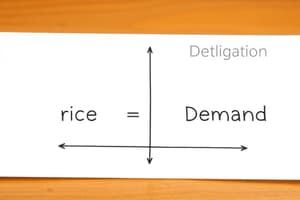Podcast
Questions and Answers
Which statement accurately describes the concept of elasticity of supply?
Which statement accurately describes the concept of elasticity of supply?
- It measures the responsiveness of quantity supplied to changes in consumer income.
- It measures the responsiveness of quantity supplied to changes in any determinant of supply. (correct)
- It measures the responsiveness of quantity demanded to changes in consumer preferences.
- It measures the responsiveness of quantity demanded to changes in price.
Price elasticity of supply (PES) measures the:
Price elasticity of supply (PES) measures the:
- percentage change in price in response to a change in quantity supplied.
- percentage change in quantity supplied in response to a percentage change in price. (correct)
- percentage change in quantity demanded in response to a change in price.
- percentage change in quantity supplied in response to a change in consumer income.
If the quantity supplied of a good increases by 5% in response to a 10% increase in its price, what is the price elasticity of supply (PES)?
If the quantity supplied of a good increases by 5% in response to a 10% increase in its price, what is the price elasticity of supply (PES)?
- 2
- 0.5 (correct)
- 1.5
- 1.0
Which of the following is NOT a method for measuring price elasticity of supply (PES)?
Which of the following is NOT a method for measuring price elasticity of supply (PES)?
Point price elasticity of supply is best used when:
Point price elasticity of supply is best used when:
Arc price elasticity of supply is most appropriate when:
Arc price elasticity of supply is most appropriate when:
If the price of wheat increases from $3 to $4 per bushel and the quantity supplied increases from 100 to 120 bushels, calculate the arc price elasticity of supply.
If the price of wheat increases from $3 to $4 per bushel and the quantity supplied increases from 100 to 120 bushels, calculate the arc price elasticity of supply.
A price elasticity of supply (PES) of 1.5 indicates that supply is:
A price elasticity of supply (PES) of 1.5 indicates that supply is:
What does a price elasticity of supply (PES) of 0 indicate?
What does a price elasticity of supply (PES) of 0 indicate?
Which type of supply elasticity is characterized by the supply curve being a vertical straight line?
Which type of supply elasticity is characterized by the supply curve being a vertical straight line?
For which of the following goods would you expect supply to be perfectly inelastic in the short term?
For which of the following goods would you expect supply to be perfectly inelastic in the short term?
In a market with unitary elastic supply, an increase in price will lead to:
In a market with unitary elastic supply, an increase in price will lead to:
When is supply considered elastic?
When is supply considered elastic?
What is the shape of the supply curve when supply is perfectly elastic?
What is the shape of the supply curve when supply is perfectly elastic?
Which of the following is the best example of a product with a perfectly elastic supply curve?
Which of the following is the best example of a product with a perfectly elastic supply curve?
How does an increase in the price of a good under elastic supply conditions affect the price elasticity of supply?
How does an increase in the price of a good under elastic supply conditions affect the price elasticity of supply?
Which of the following factors is likely to cause the supply of a product to be more elastic?
Which of the following factors is likely to cause the supply of a product to be more elastic?
A company that produces both tables and beds finds it easy to switch its production resources between the two. What does this indicate about the supply elasticity of tables and beds?
A company that produces both tables and beds finds it easy to switch its production resources between the two. What does this indicate about the supply elasticity of tables and beds?
How does the availability of storage facilities influence the elasticity of supply?
How does the availability of storage facilities influence the elasticity of supply?
How does the time required to adjust the supply affect its elasticity?
How does the time required to adjust the supply affect its elasticity?
Why might agricultural products typically have a more inelastic supply compared to bakery products?
Why might agricultural products typically have a more inelastic supply compared to bakery products?
Which factor is NOT considered a determinant of price elasticity of supply?
Which factor is NOT considered a determinant of price elasticity of supply?
How does the price elasticity of supply (PES) support business firms?
How does the price elasticity of supply (PES) support business firms?
How is the price elasticity of supply (PES) used in formulating economic policies?
How is the price elasticity of supply (PES) used in formulating economic policies?
What role does the price elasticity of supply (PES) play in international trade?
What role does the price elasticity of supply (PES) play in international trade?
How can the price elasticity of supply (PES) be used to assess the impact of government taxes?
How can the price elasticity of supply (PES) be used to assess the impact of government taxes?
Which statement best describes the importance of understanding price elasticity of supply (PES) in business and economics?
Which statement best describes the importance of understanding price elasticity of supply (PES) in business and economics?
In planning economic strategies, how should policy makers utilize the knowledge of different PES values for various goods?
In planning economic strategies, how should policy makers utilize the knowledge of different PES values for various goods?
Flashcards
Elasticity of Supply
Elasticity of Supply
Responsiveness of quantity supplied to changes in any supply determinant, measured quantitatively.
Price Elasticity of Supply (PES)
Price Elasticity of Supply (PES)
Measures the percentage change in quantity supplied relative to the percentage change in price.
Point Price Elasticity
Point Price Elasticity
Measures elasticity at a specific point on the supply curve.
Arc Price Elasticity
Arc Price Elasticity
Signup and view all the flashcards
Perfect Inelastic Supply
Perfect Inelastic Supply
Signup and view all the flashcards
Inelastic Supply
Inelastic Supply
Signup and view all the flashcards
Unitary Elasticity of Supply
Unitary Elasticity of Supply
Signup and view all the flashcards
Elastic Supply
Elastic Supply
Signup and view all the flashcards
Perfect Elastic Supply
Perfect Elastic Supply
Signup and view all the flashcards
Factor Mobility
Factor Mobility
Signup and view all the flashcards
Storage Facilities
Storage Facilities
Signup and view all the flashcards
Time to Adjust Supply
Time to Adjust Supply
Signup and view all the flashcards
Inelasticity and Prices
Inelasticity and Prices
Signup and view all the flashcards
Elasticity and Prices
Elasticity and Prices
Signup and view all the flashcards
Importance of Price Elasticity of Supply
Importance of Price Elasticity of Supply
Signup and view all the flashcards
Study Notes
Elasticity of Supply
- Measure of the responsiveness of the quantity of supply to changes of any supply determinant.
- Measured quantitatively during a specific time period, keeping all other factors constant except the considered factor.
- Primarily focuses on price elasticity of supply.
Price Elasticity of Supply (PES)
- Measurement of the percentage change in supply quantity due to percentage change in price.
- All other factors remain constant at a specific time.
- Estimates the percentage change in supply quantity in response to a 1% price change.
- Coefficient is a positive value based on the law of supply.
Methods of Measuring PES
- Point price elasticity of supply measures the percentage change in supply quantity based on a small percentage change in price at a specific supply curve point, while keeping other determinants constant.
Arc Price Elasticity of Supply
- Measures the relative percentage change in supply quantity in response to a large percentage change in price between two supply curve points.
- Calculated using the average of two prices and quantities to estimate price elasticity.
Classification of Price Elasticity of Supply
- Perfect Elastic Supply: PES = α
- Elastic Supply: PES > 1
- Unitary Elastic Supply: PES = 1
- Inelastic Supply: PES < 1
- Perfect Inelastic Supply: PES = 0
Types of Price Elasticity of Supply
- Perfect Inelastic Supply: Supply quantity remains unchanged regardless of price changes.
- Coefficient of price elasticity is 0.
- Supply curve is a vertical straight line parallel to the price axis.
- Inelastic Supply: Percentage change in supply quantity is less than the percentage change in price, with a coefficient between 0 and 1.
- Supply curve goes through the quantity axis (steeper).
- Common in agricultural products like vegetables, fruits, and fish.
- Unitary Elasticity of Supply: Percentage change in supply quantity equals the percentage change in price.
- Coefficient is always 1.
- Supply curve goes through the origin.
- Elastic Supply: Percentage change in supply quantity is greater than the percentage change in price, with a coefficient greater than 1.
- Supply curve goes through the price axis (flatter).
- Perfect Elastic Supply: Any percentage change in quantity supplied occurs without any percentage change in price.
- Coefficient is α.
- Supply curve is a horizontal straight line parallel to the quantity axis.
Relationship Between PES and Price Changes
- Changes in price under elastic supply show as an inverse relationship between price elasticity and a good's price.
- As the price increases under elastic supply, the good's price elasticity gradually decreases or when on the supply curve is moving upward along the supply curve, the price elasticity of supply decreases.
- Changes in price under inelastic supply is a direct relationship between the price elasticity of supply and the good's price.
- As the price increases under elastic supply, the price elasticity of supply increases or when on the supply curve is moving upward along the supply curve, the price elasticity of supply increases.
Determinants of PES
- Factor Mobility of Production: Ease of transferring production processes determines supply elasticity.
- Elastic supply if easy to transfer.
- Inelastic supply if difficult to transfer.
- Availability of Storage Facilities: High storage capacity leads to relatively elastic supply. If the storage capacity is loW, the good has an inelastic supply.
- Time to Adjust Supply: Elasticity depends on the time required to change supply quantity in response to price changes.
- Over a longer time period, agricultural products show that the supply is inelastic.
- Over a shorter time period, bakery products show that the supply is elastic.
Importance of PES
- Supports business firms to make decisions such as price setting and management of other factors.
- Helps in forming economic policies like how to handle agriculture, industry, government, subsidies and taxes.
- Helpful in determining the terms of trade between two countries.
- Determines the government tax burden on consumers and producers.
Studying That Suits You
Use AI to generate personalized quizzes and flashcards to suit your learning preferences.




